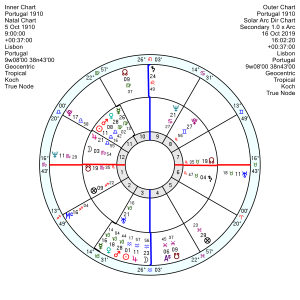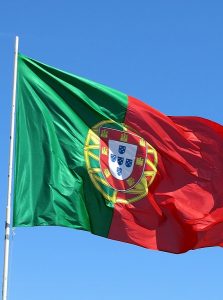Portugal, once one of the EU’s basket cases, is now applauded as a booming success. But behind the economic growth lies chronic under-investment in public services and infrastructure. Tourism is at record levels, there’s an upswing in the housing market, a growing tech sector, strong exports and foreign investment coming in. But the fear is that another recession could prove problematic and despite the recovery and the fall of unemployment, there’s a sense of precariousness with low wages a major worry.
The Portugal October 5 1910 9am Lisbon chart is on tenterhooks at the moment – both buoyed up by tr Pluto square the Jupiter till December, but also nerve-stretched as tr Pluto is conjunct the Uranus and opposition Neptune which is much less predictable and stable. Those run till late this year. Tr Uranus will have a few jolts and surprises in store as it is opposes the Scorpio Moon and is conjunct the 6th house Saturn between now and early 2020 which may have implications for employment or the health service.
Assuming the start time is accurate then tr Neptune will be in an undermining and indecisive square to the Solar Arc Midheaven till early 2020 as well. It’ll continue up and down on this chart till 2022 is clear with Solar Arc Pluto conjunct Jupiter for a distinct upswing and square the Uranus Neptune for disruptions and anxieties.
The 25 April 1974 5.15pm Lisbon chart is relatively similar with upheavals through 2021/22 as tr Pluto square the Uranus; along with at least some financial good news.
The Bank of Portugal, 15 November 1975, is jumpy at the moment with conflicting policies and erratic circumstances running into next spring; looking more cheerful in 2022 and then facing challenges in 2023 – so ups and downs.




Portugal become a country October 5, 1143. October 5, 1910 is the start of the Republic, before it was a monarchy. 25 Abril 1974 the date of the military coup that overthrew the dictartorship. Why not use a chart from the beginning of the country? It may say the same, but XX centuries charts leave the idea Portugal is a recent country.
Most wages are low and many jobs precarious, that is what causes the sense of precariousness along with rents higher than the minimum wage most Portuguese get paid or close to it.
It is not so much the under-investment in public services and infrastructure, there has been huge investiment, more the economy being mostly geared to tourism, no jobs for highly educated people that tend to leave the coutry and the already mentioned low wages.
On the other, it is an extemely safe country, the world’s third safest country.
Interesting!
I had no idea it was Catalonia’s flag (in Portuguese: Catalunha).
Well, centuries ago, two rebellions rose up in the Iberian Peninsula: Portugal and Catalonia. We had been independent for a very long time but, from 1580 to 1640 we lost our independence to Spain.
Spain, around 1640, had to choose: do they send their troops to squash the rebellion in Portugal or in Catalonia? The, hum, central government of the time, choose Catalonia – economically they were more important than Portugal.
That helped us, Portuguese, regain our independence and since then Catalonia has been figthing for theirs.
Maybe it wasn’t just gremlins in the system – maybe this was a symbol, an omen of a future – a future were Catalonia is independent, just like Portugal.
Or maybe I’m reading too much into it 🙂
Again, thank you for your reading.
Thanks Marjorie! ☺
Gremlins in the system. Definitely Portugal flag loaded and it hopped back to the Catalonia flag. Most weird. The site was migrated across to a new server last night but can’t think why it should want a Catalonia flag from two posts back. Hmm will inquire further
The flag shown is that of Catalonia. Portugal’s flag is predominantly green and red: “The flag of Portugal (Portuguese: Bandeira de Portugal) is a rectangular bicolour with a field unevenly divided into green on the hoist, and red on the fly. The lesser version of the national coat of arms (i.e. armillary sphere and Portuguese shield) is centered over the colour boundary at equal distance from the upper and lower edges£ (Wikipedia).
Hi!
Thank you for the reading – but the flag is wrong 😉
****